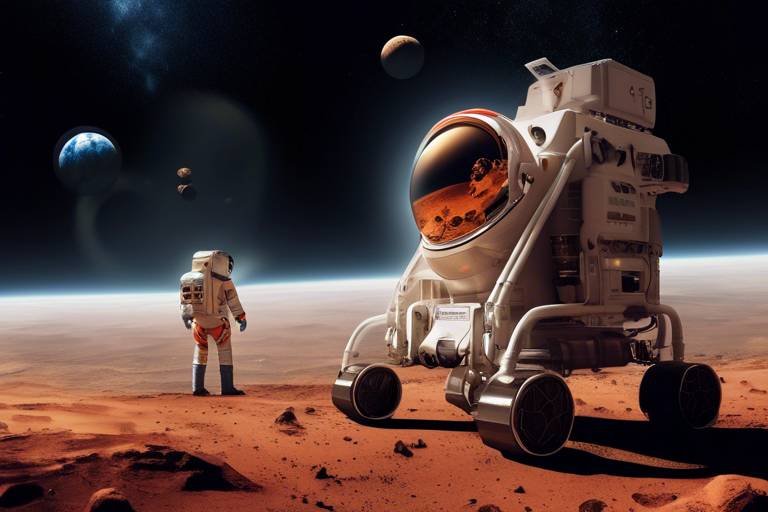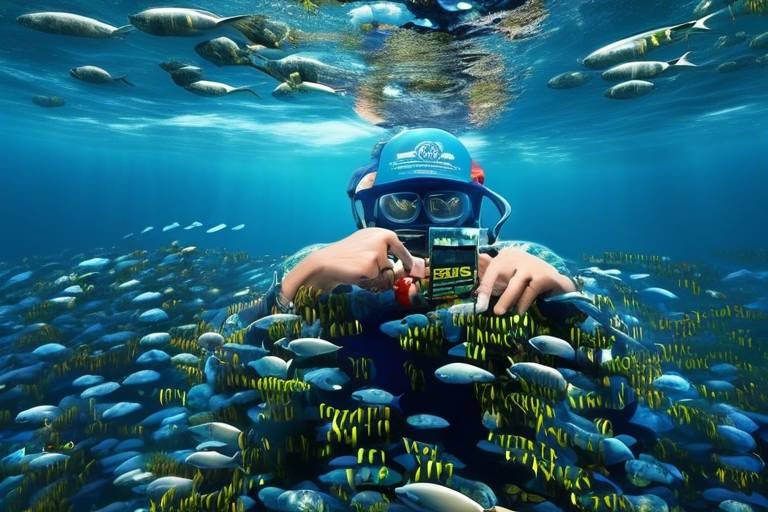The Future of Space Exploration - Missions to Mars and Beyond
Have you ever gazed up at the night sky and wondered what lies beyond our blue planet? The future of space exploration is not just a distant dream; it’s unfolding right before our eyes. With advancements in technology and a renewed interest in the cosmos, humanity is gearing up for some of the most exciting missions to Mars and beyond. This article will take you on a journey through the current landscape of space exploration, highlighting the incredible work being done to expand our presence in the universe.
As we stand on the precipice of a new era, the allure of Mars has captured the imagination of scientists, engineers, and dreamers alike. The Red Planet, with its tantalizing hints of past water and potential for life, serves as our next great frontier. But what does the future hold? From robotic explorers to human colonization, the possibilities are as vast as space itself. Buckle up as we delve into the current and upcoming missions, the technological innovations driving them, and the profound implications for humanity.
Right now, there are several remarkable missions taking place on and around Mars. NASA's Perseverance rover is diligently exploring the Martian surface, searching for signs of ancient life and collecting samples that could one day be returned to Earth. This rover is equipped with cutting-edge technology, including the MOXIE experiment, which aims to produce oxygen from Martian carbon dioxide. Meanwhile, the UAE's Hope orbiter is providing a comprehensive view of the Martian atmosphere, helping scientists understand the planet's climate and weather patterns.
These missions are not just about exploration; they are paving the way for future human missions. The data gathered from Perseverance and Hope will inform the design of habitats, life support systems, and the necessary technology for sustaining human life on Mars. The discoveries made today are the building blocks for tomorrow’s adventures in space.
Looking ahead, the excitement only intensifies. NASA's Artemis program aims to return humans to the Moon by the mid-2020s, serving as a stepping stone for future Mars missions. This ambitious initiative will not only establish a sustainable human presence on the Moon but also prepare astronauts for the challenges of Mars. On the other hand, SpaceX's Starship is making headlines with its revolutionary design aimed at interplanetary travel. Scheduled for its first crewed mission in the coming years, Starship promises to redefine how we think about space travel.
The timeline for these missions is aggressive, with many aiming for the late 2020s and early 2030s. Each mission is laden with technological innovations that will enhance our understanding of Mars, including advanced robotics and autonomous systems that can operate in the harsh Martian environment.
The future of space exploration hinges on technological advancements that make the impossible possible. From advanced propulsion systems that cut travel time to Mars, to robotics that can perform intricate tasks in space, the innovations are nothing short of astonishing. Life support systems are also evolving, ensuring that astronauts can survive long-duration missions with a sustainable source of food, water, and air.
| Technology | Description |
|---|---|
| Advanced Propulsion | Systems designed to reduce travel time to Mars. |
| Robotics | Machines that can perform tasks in extreme environments. |
| Life Support Systems | Technologies that recycle air, water, and food for astronauts. |
These innovations are not just tools; they are the lifelines that will connect us to other worlds. As we develop these technologies, we are also learning how to adapt them for use on Earth, creating a win-win situation for all of humanity.
Now, let’s talk about the big dream: colonizing Mars. Imagine a world where humans live and thrive on another planet! It sounds like science fiction, but it’s becoming a tangible goal. However, the challenges are daunting. Building habitats that can withstand the Martian environment, utilizing local resources for water and food, and addressing the psychological effects of living in isolation are just a few hurdles we must overcome.
Yet, the potential rewards are enormous. Establishing a human presence on Mars could be the first step towards becoming a multi-planetary species, ensuring the survival of humanity in the face of global challenges on Earth.
Space exploration is not just a race; it’s a collaborative effort. Countries around the world are joining forces to achieve sustainable exploration of Mars and beyond. International partnerships are essential for pooling resources, sharing knowledge, and fostering innovation. Missions like the International Space Station have set a precedent for collaboration, proving that when we work together, the sky is not the limit—it’s just the beginning.
One of the most tantalizing questions in science is whether we are alone in the universe. Astrobiology research is at the forefront of this inquiry, focusing on the potential for life on Mars. The discoveries made by current missions could provide crucial insights into whether microbial life ever existed or still exists on the Red Planet.
As we venture into new worlds, we must also grapple with ethical considerations. What responsibilities do we have to protect these celestial bodies? Planetary protection protocols are crucial to prevent contamination and preserve the integrity of other worlds. The decisions we make today will shape the future of space exploration for generations to come.
Private companies like SpaceX and Blue Origin are revolutionizing space exploration. Their innovative approaches and competitive spirit are driving down costs and accelerating timelines. The involvement of these companies is not just beneficial; it’s essential for the future of human space travel. With their resources and vision, the dream of reaching Mars is becoming a reality faster than ever.
As we look to the future, the possibilities are endless. Interplanetary travel, colonization of other celestial bodies, and a deeper understanding of the universe are all within our grasp. The journey to Mars is just the beginning of a grand adventure that could redefine humanity's place in the cosmos.
Q: When will humans land on Mars?
A: While no specific date has been set, NASA aims for the late 2020s to early 2030s for a crewed mission to Mars.
Q: What are the main challenges of living on Mars?
A: Challenges include radiation exposure, resource availability, and psychological effects from isolation.
Q: How can we protect Mars from contamination?
A: Implementing strict planetary protection protocols and conducting thorough research before missions are essential steps.

Current Mars Missions
As we stand on the brink of a new era in space exploration, are paving the way for a deeper understanding of the Red Planet. Among the most notable missions is NASA's Perseverance rover, which landed on Mars in February 2021. This remarkable piece of technology is not just a rover; it's a scientific laboratory on wheels, designed to search for signs of ancient life and collect rock and soil samples for future return to Earth. Perseverance is equipped with state-of-the-art instruments, including SuperCam, which can analyze rocks from a distance, and Moxie, a device that converts Martian carbon dioxide into oxygen. This mission is not just about exploration; it's about preparing for human missions in the future.
Another significant player in the current Mars exploration landscape is the United Arab Emirates' Hope orbiter. Launched in July 2020, this mission aims to provide a comprehensive view of the Martian atmosphere. The Hope orbiter is unique because it is designed to study the planet's weather and climate dynamics over an entire Martian year, which is about 687 Earth days. Its findings could uncover the mysteries of how Mars lost its atmosphere and provide insights into the planet's potential to support life.
These missions are not isolated efforts; they are part of a larger tapestry of international cooperation and scientific inquiry. For instance, the data collected by Perseverance and Hope will be crucial for future missions, including the upcoming Mars Sample Return mission, which aims to bring Martian soil and rock samples back to Earth for detailed analysis. This collaboration among nations and organizations exemplifies how the quest for knowledge transcends borders.
To give you a clearer picture of these missions, here’s a table summarizing their key objectives and instruments:
| Mission | Objective | Key Instruments |
|---|---|---|
| Perseverance Rover | Search for signs of ancient life; collect samples | SuperCam, Moxie, PIXL |
| Hope Orbiter | Study Martian atmosphere and weather | EMUS, EXI, RSP |
In conclusion, the current Mars missions are not just about exploring a distant planet; they represent humanity's unyielding curiosity and determination to understand our place in the universe. With each discovery, we inch closer to answering profound questions about life beyond Earth and the potential for human colonization of Mars. As these missions continue to unfold, they will undoubtedly inspire a new generation of scientists and explorers, igniting a passion for discovery that could lead to even greater achievements in the cosmos.

Upcoming Mars Missions
The excitement surrounding upcoming missions to Mars is palpable, and it's not just the thrill of exploring the unknown that gets our hearts racing. These missions represent a significant leap forward in our quest to understand the Red Planet and, ultimately, our place in the cosmos. NASA's Artemis program is one of the most anticipated initiatives, aiming to return humans to the Moon as a stepping stone for future Mars exploration. This program is not just about lunar landings; it’s about preparing humanity for the challenges of interplanetary travel.
Meanwhile, SpaceX is making headlines with its ambitious Starship project, designed to transport humans to Mars and beyond. The Starship is a fully reusable spacecraft that promises to revolutionize space travel. With its massive payload capacity and advanced design, it could pave the way for more frequent and affordable missions to Mars. Imagine a world where hopping on a spacecraft for a multi-month journey to another planet becomes as routine as booking a flight today!
To give you a clearer picture of what’s on the horizon, here’s a table summarizing some of the key upcoming Mars missions:
| Mission | Organization | Launch Year | Objectives |
|---|---|---|---|
| NASA Artemis Program | NASA | 2024 | Prepare for human missions to Mars via lunar exploration |
| SpaceX Starship | SpaceX | 2025 | Transport humans to Mars and establish a sustainable presence |
| ExoMars Rover | ESA/Roscosmos | 2028 | Search for signs of life and study Martian geology |
| Mars Sample Return | NASA/ESA | 2030s | Return samples from Mars to Earth for analysis |
As these missions unfold, they will not only enhance our scientific knowledge but also challenge our technological capabilities. For instance, the Artemis program will test new technologies that could be crucial for long-duration missions to Mars. This includes advancements in life support systems, radiation protection, and sustainable resource utilization—all essential for keeping astronauts safe and healthy on the Martian surface.
Moreover, the collaboration between agencies and private companies is set to redefine what’s possible. The pooling of resources and expertise can accelerate innovation, making the dream of Mars colonization not just a fantasy but a tangible goal. The combined efforts of NASA, ESA, SpaceX, and other organizations signify a new era in space exploration, where the barriers to entry are lower, and the possibilities are endless.
But what does this mean for you? Well, as we stand on the brink of these groundbreaking missions, we are witnessing history in the making. The next few years will be crucial in shaping our future on Mars. Are you ready to be a part of this journey? The stars are calling, and the next chapter in human exploration is just around the corner!
- What is the primary goal of the upcoming Mars missions? The main objective is to explore Mars for signs of life, prepare for human habitation, and return samples to Earth for further study.
- How will SpaceX's Starship change space travel? SpaceX's Starship aims to make space travel more accessible and cost-effective by being fully reusable, which could lead to more frequent missions to Mars.
- When can we expect humans to land on Mars? While timelines vary, NASA and SpaceX are targeting the mid-2020s for potential human landings on Mars.

Technological Innovations
As we stand on the brink of a new era in space exploration, the being developed are nothing short of revolutionary. Imagine a world where we can traverse the vastness of space with ease, thanks to advancements in propulsion systems that push the boundaries of what we thought was possible. These innovations not only promise to enhance our missions to Mars but also to unlock the mysteries of the universe beyond. For instance, NASA's recent focus on nuclear thermal propulsion could drastically reduce travel time to Mars, making the dream of human colonization a tangible reality.
But propulsion is just the tip of the iceberg. Robotics plays a crucial role in how we explore other planets. The development of autonomous rovers equipped with artificial intelligence allows for intricate exploration without the constant need for human oversight. These rovers can analyze soil samples, search for signs of water, and even make decisions based on their findings. This level of autonomy is vital for missions that may take years, where communication delays with Earth could hinder immediate decision-making.
Life support systems are another area seeing significant innovation. The challenges of sustaining human life on Mars are immense. Engineers are working on closed-loop life support systems that recycle air, water, and waste, creating a self-sustaining environment for astronauts. This technology is not only crucial for long-duration missions but also has implications for future colonization efforts. The idea of growing food on Mars using hydroponics and aeroponics is becoming more feasible, thanks to ongoing research and development.
Moreover, the integration of 3D printing technology in space exploration cannot be overlooked. Imagine being able to print tools, spare parts, or even entire habitats on Mars using local materials. This innovation reduces the need to transport everything from Earth, making missions more sustainable and cost-effective. A recent project by NASA demonstrated the potential of 3D printing by creating a prototype habitat that could withstand the harsh Martian environment, showcasing how technology can mimic Earth-like conditions.
As we delve deeper into the cosmos, the intersection of technology and exploration becomes clearer. Each advancement not only brings us closer to Mars but also prepares us for the next frontier. The future of space exploration is bright, fueled by innovation and the relentless human spirit. With every technological leap, we are not just reaching for the stars; we are paving the way for generations to come.
- What are nuclear thermal propulsion systems?
Nuclear thermal propulsion systems use nuclear reactors to heat a propellant, providing a more efficient means of propulsion compared to traditional chemical rockets.
- How does autonomous rover technology work?
Autonomous rovers are equipped with AI that allows them to analyze their surroundings, make decisions, and perform tasks without needing direct human control.
- What is 3D printing's role in space exploration?
3D printing allows astronauts to create tools and parts on-demand using local materials, significantly reducing the need for supplies to be sent from Earth.

Human Colonization of Mars
The dream of colonizing Mars has captivated the imagination of scientists, engineers, and dreamers alike. But what does it really mean to establish a human settlement on the Red Planet? Picture this: a vast, dusty landscape under a pinkish sky, where humans live in specially designed habitats, growing food in greenhouses and exploring the mysteries of the universe just outside their doors. This vision is not as far-fetched as it may seem, thanks to rapid advancements in technology and our growing understanding of Mars.
However, the journey to colonization is fraught with challenges that we must address. First and foremost, the construction of habitats on Mars is a monumental task. These habitats must provide not only shelter from harsh weather conditions and radiation but also a sustainable environment for life. Engineers are currently exploring various designs, from inflatable modules to structures made from Martian soil. The latter, known as in-situ resource utilization, could significantly reduce the amount of material we need to transport from Earth.
Another critical aspect of colonization is resource utilization. Water is essential for life, and while Mars has polar ice caps and signs of subsurface water, extracting and purifying this resource will be vital. Scientists are researching methods to extract water from the Martian soil, ensuring that future colonists have access to this crucial element for drinking, growing food, and even producing oxygen. Additionally, the production of fuel on Mars could enable return missions to Earth or further exploration of the solar system.
The psychological effects of living on another planet cannot be overlooked either. Imagine being far from Earth, surrounded by the vast emptiness of space. The isolation and confinement could take a toll on mental health, making it imperative to develop strategies for maintaining psychological well-being. Regular communication with loved ones back home, recreational activities, and a strong sense of community will be essential for the success of a Martian colony.
Moreover, we must consider the ethical implications of colonizing another planet. As we venture into this new frontier, we carry the responsibility of protecting potential Martian ecosystems. The possibility of microbial life existing on Mars poses a significant dilemma: should we prioritize exploration and colonization, or should we protect these ecosystems from contamination? Striking a balance between exploration and preservation will be crucial as we navigate this uncharted territory.
In conclusion, while the colonization of Mars presents numerous challenges, it also offers an incredible opportunity for humanity to expand its horizons. With ongoing research and international collaboration, we are inching closer to making this dream a reality. The journey to Mars is not just about reaching another planet; it's about pushing the boundaries of human potential and discovering what lies beyond our home world.
- What are the main challenges of colonizing Mars? The main challenges include habitat construction, resource utilization, psychological effects on colonists, and ethical considerations regarding potential Martian life.
- How will we obtain water on Mars? Scientists are researching methods to extract water from Martian soil and ice caps, which will be essential for drinking, agriculture, and fuel production.
- What technologies are being developed for Mars colonization? Technologies include advanced habitats, life support systems, and in-situ resource utilization techniques that allow for the use of Martian materials.
- What is the timeline for human missions to Mars? While timelines vary, NASA aims for a manned mission to Mars in the 2030s, with private companies like SpaceX also targeting similar timeframes.

International Collaboration
When it comes to the vastness of space, the saying "it takes a village" couldn't be more accurate. is at the heart of modern space exploration, creating a tapestry of shared knowledge, resources, and ambition that transcends borders. Countries around the globe are recognizing that pooling their expertise is not just beneficial; it's essential for tackling the monumental challenges of exploring Mars and beyond. Imagine a world where scientists from different nations work side by side, sharing data and insights like a global potluck of ideas. This is the reality of contemporary space missions.
Take, for instance, the International Space Station (ISS), a shining example of what can be achieved when nations unite for a common purpose. The ISS is not only a platform for scientific research but also a testament to the power of collaboration. With contributions from the United States, Russia, Europe, Japan, and Canada, it serves as a microcosm of international teamwork. Each nation brings its unique strengths to the table, whether it’s engineering prowess, scientific knowledge, or technological advancements. This collaborative spirit is paving the way for future missions, such as those to Mars.
In the realm of Mars exploration, partnerships are blossoming. NASA's Perseverance rover is not just an American endeavor; it’s a product of global collaboration, with contributions from various international teams. The rover carries instruments designed by scientists from around the world, showcasing how collective efforts can lead to groundbreaking discoveries. Similarly, the UAE's Hope orbiter is a prime example of how emerging space nations can contribute to our understanding of the Red Planet, emphasizing that exploration is a universal quest.
Looking ahead, the upcoming Artemis program aims to return humans to the Moon and eventually prepare for Mars missions. This initiative is not solely a U.S. venture; it invites participation from international partners, including ESA (European Space Agency), JAXA (Japan), and others. By working together, these agencies can share costs, reduce risks, and increase the likelihood of mission success. The collaborative nature of the Artemis program reflects a broader trend in space exploration, where the collective goal of understanding our universe takes precedence over nationalistic ambitions.
Moreover, the establishment of frameworks for international agreements, such as the Outer Space Treaty, underscores the importance of cooperation in space exploration. This treaty, signed by over 100 countries, emphasizes that space should be explored for the benefit of all humanity, laying the groundwork for peaceful and collaborative exploration. As we venture further into the cosmos, these agreements will be crucial in ensuring that our endeavors are sustainable and inclusive.
In conclusion, the future of space exploration hinges on international collaboration. As we set our sights on Mars and beyond, the partnerships forged today will be the bedrock of tomorrow's discoveries. Just like a well-orchestrated symphony, where each musician plays a vital role, the harmony of nations working together will create a beautiful melody of exploration that resonates throughout the universe.
- Why is international collaboration important in space exploration? International collaboration allows countries to pool resources, share knowledge, and tackle complex challenges more effectively, leading to greater success in missions.
- What are some examples of international collaborations in space? The International Space Station (ISS) and NASA's Artemis program are prime examples of successful international partnerships in space exploration.
- How does international law affect space exploration? Treaties like the Outer Space Treaty provide a legal framework for peaceful exploration and cooperation among nations in space.

Astrobiology and Life Beyond Earth
Astrobiology, the study of life in the universe, is a field that combines biology, chemistry, and astronomy to explore one of humanity's biggest questions: Are we alone in the universe? This captivating discipline seeks to understand the origins, evolution, and potential for life beyond Earth, particularly in the context of our closest planetary neighbor, Mars. With ongoing missions and research, Mars has become a prime candidate for astrobiological studies, providing tantalizing clues about the possibility of past or even present life.
The exploration of Mars has revealed a planet that was once much more Earth-like than it is today. Evidence suggests that ancient Mars had flowing water, a thicker atmosphere, and possibly even conditions suitable for microbial life. For instance, NASA's Perseverance rover is not just a robotic explorer; it’s a sophisticated laboratory on wheels, equipped with instruments designed to search for signs of ancient life. Its mission includes collecting soil samples that may contain organic molecules, the building blocks of life. Imagine the excitement of discovering a fossilized microbe on another planet! Such a find would not only reshape our understanding of life’s existence but also ignite a wave of questions about how life may have arisen elsewhere.
Moreover, the UAE's Hope orbiter is providing a comprehensive view of the Martian atmosphere, allowing scientists to study its composition and weather patterns. This data is crucial for understanding how Mars transitioned from a potentially habitable world to the cold, arid planet we see today. The implications of these findings stretch far beyond Mars; they help us refine our models of habitability and guide the search for life on exoplanets orbiting distant stars.
But what does it mean to search for life beyond Earth? It’s not just about finding little green men or advanced civilizations. The quest for extraterrestrial life challenges our understanding of biology itself. Life on Earth thrives in extreme environments, from the deep ocean vents to the frozen tundra. This resilience suggests that life could exist in forms we can't even imagine. As we explore Mars and other celestial bodies, we must ask ourselves: What if life exists in a form that is entirely different from what we know? This opens the door to a universe filled with possibilities.
To further understand the potential for life beyond our planet, scientists are also looking at moons like Europa and Enceladus, which harbor subsurface oceans beneath their icy crusts. These environments could be teeming with microbial life, similar to the extremophiles we find in Earth's harshest conditions. As we develop new technologies for exploration, such as advanced robotic missions and possibly crewed missions in the future, the search for life will expand beyond Mars, leading us to explore these intriguing worlds.
In conclusion, astrobiology is not just a scientific pursuit; it’s a profound journey into the unknown. As we continue to gather data from Mars and beyond, we inch closer to answering the age-old question of whether we are alone in the universe. Each discovery brings us one step closer to understanding our place in the cosmos, and with it, the potential for life that may be waiting just beyond our reach.
- What is astrobiology? Astrobiology is the study of the origins, evolution, and potential for life in the universe.
- Why is Mars a focus for astrobiology? Mars has conditions that suggest it may have once supported life, making it a key target for exploration.
- What are some signs of past life on Mars? Evidence such as ancient riverbeds, minerals that form in water, and organic compounds are indicators of past life.
- Are there other places in our solar system that might harbor life? Yes, moons like Europa and Enceladus are believed to have subsurface oceans that could support life.
- How do scientists search for extraterrestrial life? Scientists use telescopes, robotic missions, and sample analysis to search for signs of life beyond Earth.

Ethical Considerations
As we stand on the brink of unprecedented advancements in space exploration, it’s crucial to pause and reflect on the that accompany our journey into the cosmos. The excitement of exploring new worlds and potentially colonizing planets like Mars comes with a hefty responsibility. After all, as we venture into the unknown, we must ask ourselves: what are the implications of our actions on these celestial bodies?
One of the primary concerns is the idea of planetary protection. This concept revolves around preventing biological contamination of other planets, which could compromise their ecosystems—if they exist. For instance, sending rovers and landers to Mars without stringent sterilization protocols could inadvertently introduce Earth microbes to the Martian environment. This raises the question: are we prepared to take the risk of altering another planet's natural state? The Planetary Protection Policy developed by space agencies like NASA aims to mitigate these risks, but the debate is ongoing.
Moreover, as we explore the possibility of establishing human settlements on Mars, we must consider the ethical implications of resource utilization. Should we extract resources from Mars to support human life, or does this act of exploitation reflect a colonial mindset? The potential for mining water, minerals, and other resources raises questions about ownership and stewardship. Who gets to decide what is taken from another planet? Should there be an international consensus on resource management in space?
Additionally, the psychological effects of living on another planet cannot be overlooked. Imagine being part of a small community on Mars, isolated from Earth. The mental health implications of such a situation are profound. How will we support the emotional and psychological well-being of astronauts and future colonists? Establishing a sustainable and nurturing environment will be pivotal in ensuring that human beings can thrive in extraterrestrial habitats.
As we navigate these ethical waters, the role of international collaboration becomes increasingly vital. Countries must work together to establish guidelines and frameworks that govern not only exploration but also the ethical treatment of other worlds. This collaboration can help foster a sense of shared responsibility and respect for the universe we are beginning to explore.
In summary, the ethical considerations surrounding space exploration are complex and multifaceted. From planetary protection to resource utilization and mental health, each aspect requires careful thought and dialogue. As we embark on this exciting journey, let’s ensure that we do so with a commitment to ethical stewardship of the cosmos.
- What is planetary protection? - It refers to the measures taken to prevent contamination of other planets with Earth life.
- Why is resource utilization on Mars controversial? - Extracting resources raises ethical questions about ownership and the potential impact on Martian ecosystems.
- How can we address the psychological effects of living on Mars? - Developing support systems and addressing mental health needs will be crucial for future colonists.
- What role does international collaboration play in space exploration? - It helps establish guidelines and promotes shared responsibility for ethical exploration.

The Role of Private Companies
In the ever-evolving landscape of space exploration, private companies have emerged as game-changers, driving innovation and expanding the boundaries of what we thought possible. Gone are the days when only government agencies like NASA and ESA held the keys to the cosmos. Today, companies such as SpaceX, Blue Origin, and Virgin Galactic are not just participating in space missions; they are leading the charge, making space more accessible and affordable for everyone.
SpaceX, founded by Elon Musk, has become a household name in the realm of space travel. With its ambitious goal of colonizing Mars, SpaceX has developed the Starship, a fully reusable spacecraft designed to carry humans to the Red Planet and beyond. This innovation is not just about getting to space; it’s about making the journey sustainable. The Starship program aims to reduce the cost of space travel significantly, making it feasible for more than just astronauts. Imagine a future where vacations to Mars are as common as trips to Europe!
Meanwhile, Blue Origin, founded by Jeff Bezos, focuses on making space travel more routine. Their New Shepard suborbital vehicle is designed for space tourism, allowing civilians to experience weightlessness and see Earth from a new perspective. This is a crucial step in normalizing the idea of space travel, as it opens the door for the next generation of explorers—people who aren’t just scientists or engineers, but everyday individuals with dreams of the stars.
But it’s not just about the big names. Numerous startups are entering the fray, working on various aspects of space technology. For instance, companies like Rocket Lab and Relativity Space are innovating in the realm of small satellite launches and 3D-printed rockets, respectively. This diversity in the industry is fostering a competitive environment that accelerates technological advancements.
The collaboration between private companies and government agencies is also noteworthy. NASA has partnered with several private entities through its Commercial Crew Program, allowing companies like SpaceX and Boeing to transport astronauts to the International Space Station (ISS). This partnership not only reduces costs for NASA but also stimulates economic growth within the private sector. It’s a win-win situation that exemplifies how public and private sectors can work together to achieve remarkable feats.
However, with great power comes great responsibility. As private companies take on more roles in space exploration, there are pressing questions about regulation, safety, and environmental impact. The potential for space debris and the need for sustainable practices are concerns that must be addressed. Companies must prioritize planetary protection and ensure that their missions do not harm celestial bodies or compromise future exploration efforts.
In conclusion, the role of private companies in space exploration is not just a trend; it’s a transformative force that is shaping the future of humanity’s journey into the cosmos. As these companies continue to innovate and push boundaries, we stand on the brink of a new era in which space travel becomes part of our everyday lives. The possibilities are endless, and the stars are closer than ever before.
- How are private companies changing space exploration?
Private companies are introducing innovative technologies and reducing costs, making space more accessible. - What is SpaceX's main goal?
SpaceX aims to colonize Mars and develop sustainable space travel solutions. - Are private companies working with government agencies?
Yes, many private companies collaborate with agencies like NASA to enhance space missions. - What are the concerns with private space exploration?
Concerns include regulation, safety, and environmental impact, particularly regarding space debris.

Future of Space Exploration
The future of space exploration is not just a distant dream; it's an exhilarating journey that is well underway! Imagine a world where humans travel to distant planets, establish colonies, and perhaps even engage with extraterrestrial life. This vision is becoming increasingly tangible as technology advances and our understanding of the universe deepens. The quest for knowledge and survival pushes us to look beyond our blue planet, and the possibilities are as vast as space itself.
One of the most thrilling aspects of this future is the potential for interplanetary travel. With missions planned for Mars, the next big leap could involve traveling to the moons of Jupiter or Saturn. Each celestial body presents unique challenges and opportunities, and the prospect of human beings walking on these distant worlds is becoming less of a fantasy and more of a reality. The technology we develop today will lay the groundwork for these journeys, enabling us to explore and perhaps even colonize other planets.
As we gaze into the cosmos, we must also consider the colonization of other celestial bodies. Mars is often seen as the prime candidate for human settlement due to its similarities to Earth. Scientists are actively researching how we can create sustainable habitats on Mars, utilizing local resources to support human life. This includes everything from growing food in Martian soil to extracting water from ice deposits. The challenges are immense, but so are the rewards. Establishing a human presence on Mars could serve as a stepping stone for further exploration of the solar system.
Moreover, the role of private companies in this grand exploration scheme cannot be understated. Companies like SpaceX and Blue Origin are revolutionizing how we think about space travel. Their innovations are not only making space more accessible but also driving down costs. As these companies continue to push the envelope, we can expect a surge in missions that could pave the way for a new era of exploration.
In addition to technological advancements, the exploration of space also poses significant ethical considerations. As we venture into new territories, we must grapple with questions surrounding planetary protection and the potential contamination of other worlds. What responsibilities do we hold as we explore? How can we ensure that our quest for knowledge does not come at the expense of potential alien ecosystems? These are critical discussions that must accompany our exploration efforts.
Finally, the future of space exploration is not just about human presence in the cosmos; it’s also about the search for extraterrestrial life. The ongoing research in astrobiology is crucial as we seek to understand whether we are alone in the universe. The discoveries made on Mars and other celestial bodies could provide vital clues about the existence of life beyond Earth. The implications of finding life, whether microbial or intelligent, would be nothing short of revolutionary.
In conclusion, the future of space exploration is a tapestry woven with ambition, innovation, and responsibility. As we continue to push the boundaries of our understanding, we move closer to unlocking the mysteries of the universe. The journey ahead is fraught with challenges, but the rewards—new worlds, new knowledge, and perhaps new life—are worth every effort. So, buckle up, because the adventure is just beginning!
- What is the primary goal of Mars missions? The main aim is to explore the planet's surface, search for signs of past life, and assess its potential for human colonization.
- How do private companies contribute to space exploration? Private companies are innovating technologies and reducing costs, making space travel more accessible and frequent.
- What ethical concerns arise with space exploration? Ethical concerns include planetary protection, the potential for contamination, and the responsibilities humanity holds towards other worlds.
- Will humans ever colonize Mars? While there are significant challenges, advancements in technology and research suggest that colonization could be possible in the coming decades.
- What role does astrobiology play in space exploration? Astrobiology helps us understand the conditions necessary for life, guiding our search for extraterrestrial life and informing our exploration strategies.
Frequently Asked Questions
- What are the current missions exploring Mars?
The current missions exploring Mars include NASA's Perseverance rover, which is actively searching for signs of ancient life and collecting samples, and the UAE's Hope orbiter, which is studying the Martian atmosphere to understand its climate and weather patterns. These missions are crucial as they provide valuable data that will inform future explorations and potential colonization efforts.
- What upcoming missions to Mars should we be excited about?
Exciting upcoming missions to Mars include NASA's Artemis program, which aims to return humans to the Moon and prepare for future Mars missions, and SpaceX's Starship, designed for interplanetary travel. These missions are set to push the boundaries of technology and human exploration, with timelines targeting the mid-2020s for initial crewed missions.
- What technological innovations are being developed for Mars exploration?
Technological innovations for Mars exploration include advanced propulsion systems that could significantly reduce travel time, robotics for autonomous exploration, and life support systems to sustain human life during long-duration missions. These breakthroughs are essential for making the dream of living on Mars a reality.
- What challenges do we face in colonizing Mars?
Colonizing Mars presents several challenges, including constructing habitats that can withstand harsh conditions, utilizing local resources for survival, and addressing the psychological effects of isolation and distance from Earth. Overcoming these hurdles will be vital for establishing a sustainable human presence on the Red Planet.
- How important is international collaboration in space exploration?
International collaboration is crucial in space exploration as it allows countries to pool resources, share knowledge, and work towards common goals. Collaborative missions can enhance the sustainability of exploration efforts and foster peaceful relations among nations as they explore the cosmos together.
- What is the significance of astrobiology in the search for life beyond Earth?
Astrobiology plays a vital role in understanding the potential for life beyond Earth, particularly on Mars, which may have harbored microbial life in the past. Research in this field helps us identify biosignatures and understand the conditions that could support life, guiding future missions aimed at finding extraterrestrial organisms.
- What ethical considerations are involved in space exploration?
Ethical considerations in space exploration include planetary protection to prevent contamination of other worlds, the responsibilities of humanity as we venture into new territories, and the potential impact on any existing ecosystems. These factors must be carefully weighed to ensure that exploration is conducted responsibly.
- How are private companies influencing space exploration?
Private companies like SpaceX and Blue Origin are revolutionizing space exploration by developing innovative technologies and reducing costs. Their involvement is accelerating the timeline for missions to Mars and expanding opportunities for commercial space travel, making the dream of interplanetary exploration more accessible than ever.
- What does the future hold for space exploration?
The future of space exploration is incredibly promising, with potential for interplanetary travel, colonization of other celestial bodies, and a deeper understanding of the universe. As technology advances and international cooperation grows, humanity is on the brink of a new era of exploration that could redefine our place in the cosmos.



















